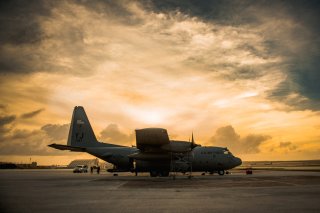General Van Ovost Plans to Weaponize Cargo Aircraft
General Van Ovost talked about arming cargo planes with air-to-ground weapons.
Here's What to Remember: We have to change the way we think about what we do.
As platforms that deliver food, water, ammunition, forces, and weapons into high-risk forward warfare locations, U.S. Air Force tankers and cargo planes are built to operate in war. Propeller-driven C-130s, for example, are built to airdrop vital supplies in hostile, austere environments where standard engine-propelled aircraft might not be able to operate. They have flares and other countermeasures to thwart ground-to-air missile attacks and regularly land in well-defended forward runway areas with a secure perimeter. But what about transitioning them more fully into armed warplanes capable of dropping bombs, controlling attack drones, or even firing missiles in flight?
A smart idea, says Gen. Jacqueline Van Ovost, Commander of the Air Mobility Command, who says that transport and utility aircraft need to continuously be adapted to operate in a massive, great-power, technologically advanced war. All planes, it could be argued, need to ensure they are armed warplanes built with sensors, electronic warfare weapons, countermeasures, and offensive weapons. In a discussion with the Mitchell Institute for Aerospace Studies, Van Ovost explained that Air Mobility Command continues to explore new innovative tactical methods through which cargo and utility aircraft can support a joint, multi-domain fight.
“We have to change the way we think about what we do. We are shifting our focus to the high-end fight. It is not enough to just bring mobility capacity but we also want to bring more to the joint force. We want to be ready and relevant for the future. We need time and capacity to experiment and think outside of the box,” Van Ovost said.
For instance, Van Ovost talked about arming cargo planes with air-to-ground weapons, launching attack drones or dropping bombs from C-130s, or even using a C-17 aircraft as a forward command and control “node to do crunching of data.”
“We showed that a C-17 with a set of antennas could do that work. We have the size, weight, and power. A pod on an airplane will do C2 to process data and make that available,” she explained.
This thinking expands beyond a C-17, according to Van Ovost, who said even KC-46 tankers could perform critical airborne command and control operations functioning as a key data-organizing and sharing “node” in the sky able to instantly connect with F-35s, F-22s, and Valkyrie drones. She developed this thinking even further, suggesting that KC-46 tankers could integrate with a network and themselves “become the network forward.” It could be a forward node for beyond-line-of-sight connectivity with ground control stations and other vital assets such as airborne 5th and 6th-generation aircraft and drones.
“F-35s can also feed raw threat data into a KC-46 which processes that information and sends it to a place where Airmen can begin to develop countermeasures,” Van Ovost said.
Van Ovost envisions a future Air Mobility Command as a multi-functional, multi-domain, and weaponized warfare entity that is “more connected and more interoperable to provide that resiliency, present credible capacity and execute at pace and scale necessary to win the future fight.”
Kris Osborn is the defense editor for the National Interest. Osborn previously served at the Pentagon as a Highly Qualified Expert with the Office of the Assistant Secretary of the Army—Acquisition, Logistics & Technology. Osborn has also worked as an anchor and on-air military specialist at national TV networks. He has appeared as a guest military expert on Fox News, MSNBC, The Military Channel, and The History Channel. He also has a Master's Degree in Comparative Literature from Columbia University.
This article is being reprinted for reader interest.
Image: Flickr

